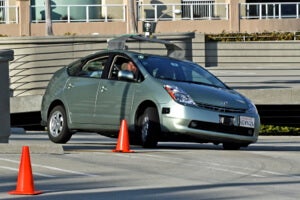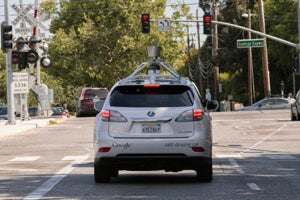Summit Europe: When Will We Let Go and Let Google Drive Us?

Share
What technology has the most world-changing potential in the next decade or two?
Brad Templeton, Singularity University’s networks and computing chair, thinks it's driverless cars. Then again, he would. Templeton has worked with Google on robot cars for several years. He thinks the technology will be transformative, not simply because it’s possible (which it is)—but because it solves a long list of problems.
Speaking at Singularity University's Summit Europe yesterday, Templeton made the case for cars that drive themselves. You’ve likely heard some of it. The prime argument is that humans, frankly, aren’t that good at driving—1.2 million people die around the world each year in car accidents according to Templeton.
But it’s more than that. Some drive for the love of driving, but most drive to get places. Commuting takes up a huge fraction of our lives. If we don't have to operate the car, we can use that time doing other things, like catching up with family or working. Further, while we’re mostly commuting to a job, we also drive to leisure activities. The great thing about robots is that they don’t drink, and they always pay attention.
Self-driving cars will also greatly benefit the elderly or disabled—taking them where they want to go, instead of taking their freedom.
And Templeton goes further. Why buy your own driverless car when you can simply hire one tailored to your need? Some of us purchase trucks to occasionally haul cargo or SUVs to visit the mountains a few times a year. Even so, we primarily use cars for normal stuff like shopping or going to work—things we don’t need a truck or SUV to accomplish.
Uber, or some other future car service, might simply deliver to your doorstep the right driverless car at the right time: a truck for hauling, an SUV for the mountains, but most of the time, an efficient city or comfortable commuting car. In such a scenario, there might not be a need to park very often at all—the cars would cycle through passengers day and night.
Ultimately, driverless cars would reduce accidents, congestion, even transform the design of cities. The question is, how soon?
Daimler promises near-driverless cars by 2020. Tesla says 2016. But definitions of "self-driving" vary. Tesla, for example, isn't promising completely driverless cars by 2016, just more autonomy than at present.
Templeton thinks Google is way ahead of traditional players. And though we’ll have regular cars with humans at the wheel for awhile yet, he thinks driverless cars will begin noticeably infiltrating the fleet in the 2020s.
That said, there’s still plenty of work to be done. Google has racked up most of their 700,000 miles on highways. They’re only now tackling city streets—a more difficult problem. I recently heard of a (non-Google) car that, using cameras to detect and avoid obstacles, slammed on its brakes to avoid a column of steam from a manhole. I don't know if Google's system of lasers would be similarly fooled, but there are many specific situations in urban driving that will have to navigated.
And it isn’t just the technology that will have to be ready for the real world. The general public will need to adapt to the technology as well.
Be Part of the Future
Sign up to receive top stories about groundbreaking technologies and visionary thinkers from SingularityHub.


According to Templeton, regulators and policymakers are proving more open to the idea than expected—a number of US states have okayed early driverless cars for public experimentation, along with Singapore, India, Israel, and Japan—but earning the general public's trust may be a more difficult battle to win.
No matter how many fewer accidents occur due to driverless cars, there may well be a threshold past which we still irrationally choose human drivers over them. That is, we may hold robots to a much higher standard than humans.
This higher standard comes at a price. “People don’t want to be killed by robots,” Templeton said. “They want to be killed by drunks.”
It’s an interesting point—assuming the accident rate is nonzero (and it will be), how many accidents are we willing to tolerate in driverless cars, and is that number significantly lower than the number we’re willing to tolerate with human drivers?
Let's say robot cars are shown to reduce accidents by 20%. They could potentially prevent some 240,000 accidents (using Templeton's global number). That's a big deal. And yet if (fully) employed, they would still cause nearly a million accidents a year. Who would trust them? And at what point does that trust kick in? How close to zero accidents does it have to get?
And it may turn out that the root of the problem lies not with the technology but us.
Most laws so far require a human to be at the wheel of a driverless car (just in case). But Google took the steering wheel, brakes, and gas pedal out of their most recent driverless model. Why? Because they found the handoff from computer to human is dangerous. In fact, the driverless car being driven by a human is the only crash to date.
Templeton noted a similar trend in aviation with autopilot—the handoff from automated system to human controller is problematic. We may find the safest strategy is to go directly from full human operation to machine operation with no intermediary—a scenario that would, no doubt, be hard for regulators to accept.
Ultimately, Templeton thinks these and other challenges aren’t insoluble, and the benefits speak for themselves. Driverless cars will be on the road in the next decade or so. Salim Ismail, commenting onstage after Templeton’s talk, agrees. “I have a three year old son,” Ismail said,” who may never get a driver’s license.”
Image Credit: Steve Jurvetson/Wikimedia Commons;
Jason is editorial director at SingularityHub. He researched and wrote about finance and economics before moving on to science and technology. He's curious about pretty much everything, but especially loves learning about and sharing big ideas and advances in artificial intelligence, computing, robotics, biotech, neuroscience, and space.
Related Articles

Data Centers in Space: Will 2027 Really Be the Year AI Goes to Orbit?

These Robots Are the Size of Single Cells and Cost Just a Penny Apiece

Hugging Face Says AI Models With Reasoning Use 30x More Energy on Average
What we’re reading


